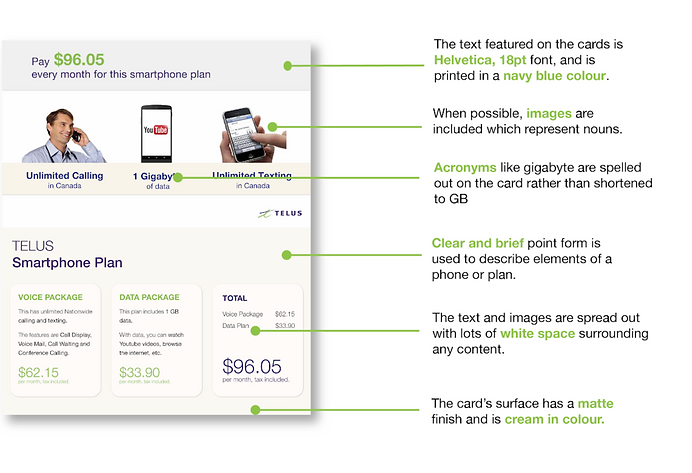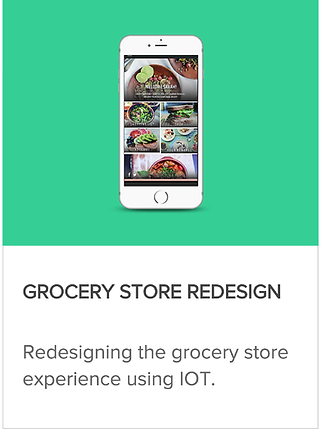TELUS CARDS
An in-store sales aid to help prospective customers with Autism Spectrum Disorder more easily understand TELUS phone plans.
✓ Researcher
✓ Designer
✓ User Testing Lead


PROJECT OVERVIEW
TELUS Digital challenged teams at the University of Waterloo Stratford School to improve the in-store purchasing experience at TELUS for customers with disabilities. Alongside a team of four others*, I designed TELUS Information Cards: a deck of cards that explains key details of individual TELUS phone plans designed for customers with Autism Spectrum Disorder.
We decided to explore challenges of people with Autism Spectrum Disorder (ASD).

RESEARCH
I reviewed multiple articles and studies about people with ASD. I interviewed a social worker that works with people with ASD, a person with Asperger’s Syndrome, and parents of young adults with high, mid, and low functioning ASD.
Between online research and our series of interviews, we developed a better idea of the daily challenges that people with ASD might face.

My team and I travelled to seven different TELUS store locations.
Previously learning about our users through online research and interviews helped position our mindsets for site visits. We noted the way that employees interacted with customers, the physical sales tools they used, took note of the layout of the room and observed conditions like lighting and sound.


We continued by visiting TELUS competitors like Bell and Rogers to see how they compared with the TELUS locations. We wanted to get a general sense of the competitive landscape but also scope out techniques that might inspire solutions for our users.

THE PROBLEM
TELUS brochures were actively presented to us at all seven locations. They were either used to explain the phone plans or given to us to take home.
We came to the conclusion that understanding TELUS plans on these brochures is hard enough for neurotypical people. Based on what we knew about people with ASD, our team agreed that it could be next to impossible for users with ASD to understand TELUS plans without being overwhelmed by the presentation of information.

We wanted to design a sales aid that easily describes phone plans in a manner that is easy for someone with ASD to interpret.

IDEATION
To get the team motivated, I held multiple creative brainstorming sessions to get everyone thinking about the topic of information processing. We timed ourselves completing memory games using different strategies and noted which variations were best at sparking our memories.
Focusing on one thing at a time made it so much easier to interpret and remember information—this inspired us to create a deck of cards where each card features a single phone plan rather than recreating a brochure that tries to squeeze every bit of information into one page.


When sitting down to design the layout of our cards, we came to a quick realization. We could pinpoint tons of reasons the current TELUS brochures were missing the mark, but we didn’t know much about designing print material for this specific user group.

MORE RESEARCH
I researched the most successful methods of presenting information to a person with ASD.
This included types of text, images, layouts, and colours to be used in print design. I summarized all of this information into a simple chart so that our whole team could use it as a guidebook for making design decisions.

PROTOTYPING
I encouraged everyone on our team to design a prototype of a single information card. We came together to present each of our ideas and decided what worked and what didn’t.



Based on these ideas, I worked with another designer to create two prototypes to be used for testing.



TESTING
We tested our prototypes with a couple of students who have high functioning ASD but mostly tested with neurotypical university students. Before testing, I created a document that summarized our overall goals, questions, what we were hoping to gain from each question, and each team member’s role during the sessions.
I set up a camera and tripod and filmed our testing process so that we could review it later for additional analysis.
We conducted usability testing with our participants.

I took all of the information we gathered from testing and summarized it into specific changes we could use to improve the design.
It was interesting to see that the more successful prototype was not the design with the more modern look—it was the prototype that used stock images rather than icons that was the most successful. We iterated on our previous design considering our testing feedback and the design document I had previously created.

BUSINESS PLAN
As we iterated the final designs of our prototype, we fleshed out a business plan.
Our information cards showed market potential because their benefits were not solely for people with ASD.
People who experience similar painpoints such as difficulty processing complex information or simply people who are purchasing a phone plan for the first time can also benefit from this resource. Our team developed a marketing plan and projected a three-year financial plan to compliment our solution.


FEEDBACK
We presented our iterated solution and sent a package of information to TELUS Digital for consideration as they developed their accessibility centers of excellence.
*TEAM MEMBERS
Andrew Muscat, Dhara Pitroda, Helena Wang, Larissa Dufresne



